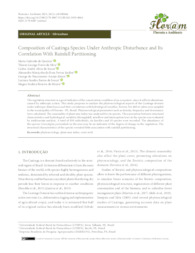Composition of Caatinga species under anthropic disturbance and its correlation with rainfall partitioning.
Composition of Caatinga species under anthropic disturbance and its correlation with rainfall partitioning.
Author(s): QUEIROZ, M. G. de; SILVA, T. G. F. da; SOUZA, C. A. A. de; JARDIM, A. M. daa R. F.; ARAÚJO JÚNIOR, G. do N.; SOUZA, L. S. B. de; MOURA, M. S. B. de
Summary: The vegetation structure is a good indicator of the conservation condition of an ecosystem, since it reflects alterations caused by anthropic action. This study proposes to analyze the phytosociological aspects of the Caatinga domain under anthropic disturbance and their correlations with hydrological variables. Twenty-five 400 m2 plots were sampled in the municipality of Floresta - PE, Brazil. Phytosociological parameters such as density, frequency and dominance were calculated. The seasonality of plant area index was analyzed for six species. The association between structural characteristics and hydrological variables (throughfall, stemflow and interception loss) in the species was evaluated by multivariate analysis. A total of 930 individuals, six families and 10 species were recorded. The abundance of the species Cenostigma pyramidale in the area may be an indicator of the degree of change in the vegetation. The structural characteristics of the species revealed little association with rainfall partitioning.
Publication year: 2021
Types of publication: Journal article
Unit: Embrapa Semi-arid Region
Observation
Some of Embrapa's publications are published as ePub files. To read them, use or download one of the following free software options to your computer or mobile device. Android: Google Play Books; IOS: iBooks; Windows and Linux: Calibre.
Access other publications
Access the Agricultural Research Database (BDPA) to consult Embrapa's full library collection and records.
Visit Embrapa Bookstore to purchase books and other publications sold by Embrapa.

